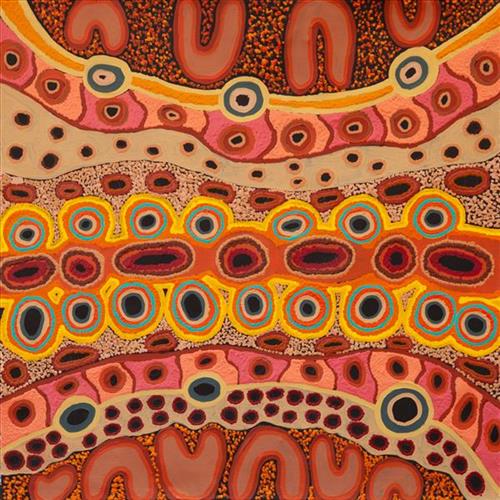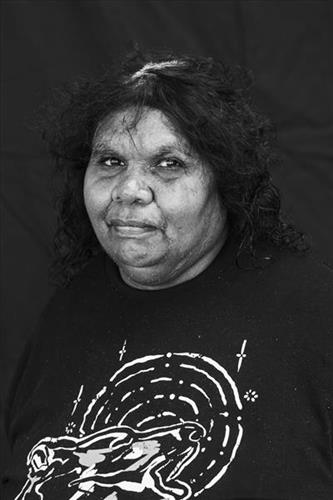Biography:
“My mother and father were from Wiluna area. I was born out in the desert, Melrose Station near Wiluna. My mum and dad were working on the station there then. I did my schooling there, but I moved to Jigalong as a young girl, then had my first child there. I’ve got three children and a step son too.
[I started painting ] in Jigalong, one day at that little art shed there when Gabrielle [Sullivan, inaugural manager of Martumili Artists] was still the manager. When I shift to Newman I started painting in that old centre sometimes.
One day at this new [art centre] building I just started coming in with Anya [Judith Samson]. She was giving me a little bit of advice, saying I should come in and do something! I just started doing it then, doing it more and more. It’s good to paint. I was looking at other people that paint, seeing their paintings get sold, so I thought “Oh yeah, I’ll start then!” It’s fun. I couldn’t stop painting now, I’m painting every day!
I tried every painting style. Now I found this different way to paint, doing the dot paintings, and this is the one I like most. It’s relaxing! I use a long stick. I paint all the different colours I see out in Country. I like to paint about all the bush foods and wildflowers. We go out getting honey ants and bush potatoes from the ground and bush bananas on a tree, hunting for goanna.
I work with KJ [local ranger group, Kanyirninpa Jukurrpa), take the kids out Country, out in the bush. ‘Kids on Country’ we call it. It helps them to go out Country. When they go out and see the countryside and the bush, makes them feel a bit happy and like they want to go out more and more. I help take them out to track a goanna, take them right up to the hole and they dig it out. Any kids can come- like eight (years), ten, twelve, fourteen… We work with the ones who wonder around in Newman, who aren’t going to school. Some kids don’t like going to school- their parents send them to school but they go around another way. It’s important for them to learn the traditions from their old people so they can be proud of themselves. I paint about the same things they learn out on Country; going and getting the honey ants, goanna, bush tomatoes and bush berries. I also do patrol at night with the women’s shelter to help the kids, help [their] families. They need someone like me to go out and help them and take them home.
I’ve had my painting in the gallery here in Newman. That felt good to see my painting on the wall. I feel happy and proud when someone buys one of my paintings.”
- Marlene Anderson
Marlene Anderson has painted with Martumili Artists for over a decade. In fact, she participated in one of Martumili’s earliest workshops, held in the Jigalong art shed in 2010. It’s only in recent years, however, that Marlene has become one of our core artists; she can be found painting at home or in the Newman studio nearly every day. For Marlene, painting has become a perfect means of expressing the ninti (cultural knowledge) she helps pass to local Aboriginal youth.




